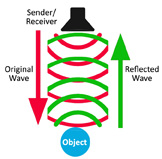How Ground Penetrating Radar (GPR) Works
 A high-frequency radar wave governed by electromagnetic properties is propagated into the ground at a rapid rate. The two-way travel time of the wavelength is measured. The speed of the radar wave is dependent on the material it is penetrating. Anytime the wave passes a boundary (change in physical properties) an anomaly is seen in the data set and can be marked out in real time by a Certified GPR Technician.
A high-frequency radar wave governed by electromagnetic properties is propagated into the ground at a rapid rate. The two-way travel time of the wavelength is measured. The speed of the radar wave is dependent on the material it is penetrating. Anytime the wave passes a boundary (change in physical properties) an anomaly is seen in the data set and can be marked out in real time by a Certified GPR Technician.
Measure concrete thickness
By measuring the two-way travel time of the radar wave, Structure Scan’s GPR Technicians can determine /confirm slab thickness, concrete cover over steel reinforcement and accurate depth measurements to subsurface targets.
Locate objects embedded in concrete
Structure Scan’s GPR Technicians can quickly and accurately locate rebar, post tension cables, conduits, radiant heating lines and other objects embedded in concrete.
Void detection
Contrasting dielectric properties between air and concrete enable Structure Scan’s GPR Technicians to locate voids beneath asphalt and pavement, and confirm substrate displacement without opening and destroying the integrity of the slab.
3D subsurface imaging
Images of data collected can be provided in raw, 2D and 3D formats, by hard copy, e-mail or digital media.
Data digitally archived
Data collected is digitally archived for future reference.
Map location
An optical survey wheel encoder enables Structure Scan’s GPR Technicians to quickly and accurately map out the depth and location of rebar right on the concrete.
Concrete infrastructure evaluation
By mapping out the strength of reflectors, Structure Scan’s GPR Technicians can quickly and accurately locate areas of concrete deterioration.
GPR reports
On-site data processing and real-time reporting available.
GPR reports are private and confidential.
